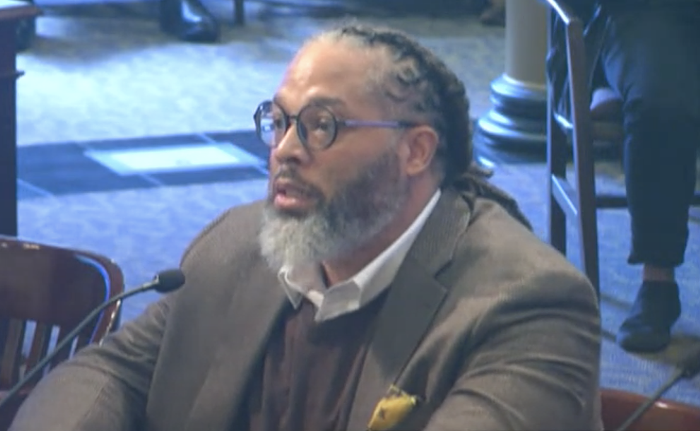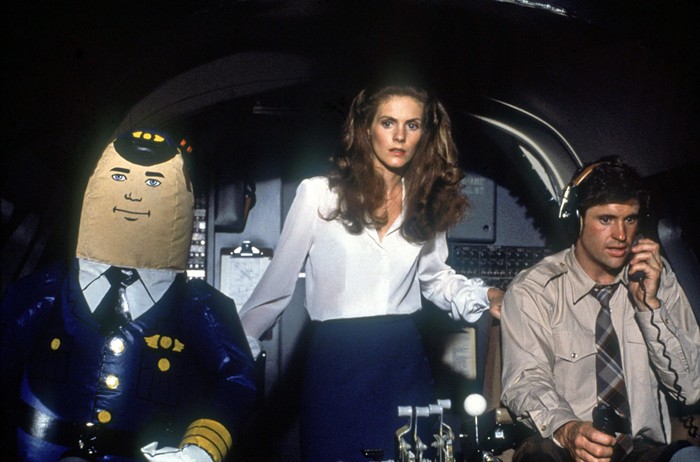Last night at PSU's Lincoln Hall, vocalist and musician Liz Harris (aka, Grouper) and experimental filmmaker Paul Clipson performed Hypnosis Display for the first time on US soil. The 75-minute, live audiovisual collaboration, commissioned by Opera North, is sourced from Harris' field recordings and Clipson's in-camera-edited films that capture naturalistic and man-made American landscapes. The performance notes on PICA's website hint at the piece's significance: "Hypnosis Display envelops viewers in deeply felt connections to landscape, environment, and place. With an attentive yet neutral eye, the film reflects on the American experience and what creates a sense of being at 'home.'"
The piece starts with a tangled and cacophonous take on nature: Using an array of cassette players, Harris mixes together sounds of water, while Clipson matches the ominous rumble with overlapping closeups of turbulent, oceanic surfaces. The water travels forward, across America. Breaking waves wash over the hard lines of pipes and wires, across unnamed roads and flashes of faces. Water beads up on green leaves, hangs in drops from blades of grass, feeds into the lush and later, the concrete. We're never in one place at one time. Both audio and visual layer and stack locations and subjects. Jittery edits of broken windows introduce an increasingly intense pace and, meanwhile, juxtapositional content becomes the rule. The piece moves from coast to continent, shuffling together instances of city infrastructure and places where the natural world edges back in, looking at technological order, human order, and ecological order (and where these forces fit into one another) with kaleidoscopic irreverence for the divisions in between.
As the title suggests, we're dealing with a hypnotic and dreamlike piece, though in terms of reflecting the American experience, I'm not sure that I follow. The sights and sounds didn't really bear an appearance I would describe as uniquely American. Undersides of bridges and closeups of disembodied legs, neon signs and streaks of light, could be from anywhere where these things exist. We're told that the films and field recordings are of America, therefor about America, but what is being said about America— about "a sense of being at 'home'"— isn't really clear. Is it that America is now a place like any other place? That what makes America distinct is its most indistinct features? Is it a way of pointing out the hegemonic quality of Western culture? Or, like the craftsmanship of the piece, is it that America is frantic, always divided, a culture in superposition and chaos?
I couldn't say.
Additionally, the claim that Hypnosis Display "envelops viewers in deeply felt connections to landscape, environment, and place" didn't hold up from my seat. The wild-eyed edits and ever-changing poly-subjects did less to envelope me and more to push me out, and after seeing Tim Hecker's TBA set last Sunday— which absolutely sucked me in and imparted environmental sensations— I was pretty underwhelmed. Halfway through Hypnosis Display, when images stopped for a reel-change, I was ready for things to wrap up, and subsequently didn't notice any specific moments that announced the necessity of the second half of the performance (which isn't to say things were unpleasant, just not super compelling).
When exiting the auditorium, one friend groggily commented that she'd fallen asleep, another that they had to close their eyes a lot because all the pulsing and flashing and never standing still got to be too much. A local comedian buddy noted that he would've given the piece about thirty seconds in any setting that wasn't "auditorium."
Ouch. It's a case of less is more, I think. And also a case of a project that might be a little too coy about how it packages and relates its significance.
Regardless, we can take it as a reminder that mastery of technique and craftsmanship don't guarantee an outcome that people connect with, and that artists might be wise to put an audience's needs before their own.


















